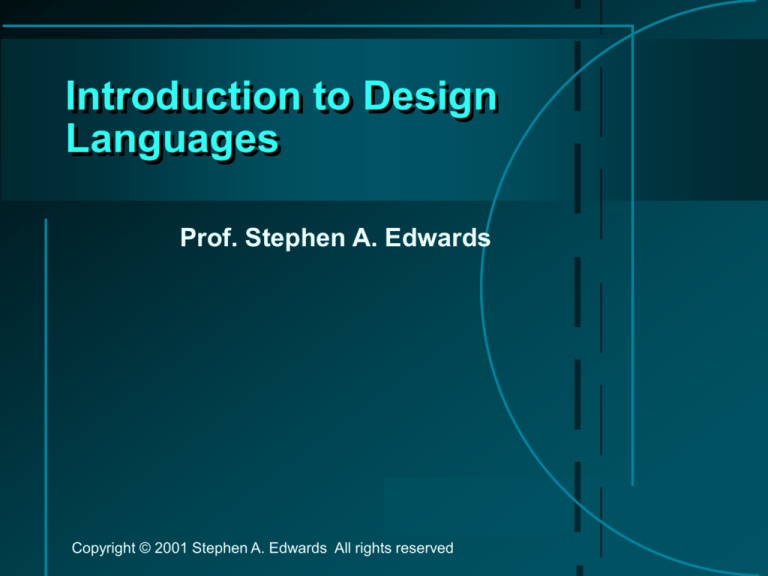
Introduction to Design
Languages
Prof. Stephen A. Edwards
Copyright © 2001 Stephen A. Edwards All rights reserved
Last Time
Introduction to the class
Embedded systems
Role of languages: shape solutions
Project proposals due September 26
•
Do you know what you’re doing?
Copyright © 2001 Stephen A. Edwards All rights reserved
Lobby, Paris Opera
House
This Time
General ideas behind languages
Syntax, Semantics, and Models of Computation
Specification versus Modeling
Concurrency: Two things at once
Nondeterminsm: Unpredictability
Types of communication: Memory, broadcasting
Hierarchy
Copyright © 2001 Stephen A. Edwards All rights reserved
Syntax, Semantics, and Model
Marionette model
You control the syntax
The semantics connect the
syntax to the model
You ultimately affect a model
Copyright © 2001 Stephen A. Edwards All rights reserved
Syntax
Formally:
Language: infinite set of strings
from an alphabet
Rosetta stone
Alphabet
•
DNA
{A T G C}
•
Student Transcripts
{w1007-02 w1009-01 w4559-02 …}
•
English
{aardvark abacus abalone …}
•
Verilog
{always module …}
Copyright © 2001 Stephen A. Edwards All rights reserved
Computational Model
What a string ultimately affects
Does not need to be unique
Babbage’s
Difference Engine
Model
•
DNA
Proteins suspended in water
•
Student Transcripts
Your knowledge
The admiration of others
•
English
Natural language understanding
•
Verilog
Discrete event simulator
Netlist of gates and flip-flops
Copyright © 2001 Stephen A. Edwards All rights reserved
Semantics
How to interpret strings in the model
Also not necessarily unique
“When I use a
word, it means
just what I
choose it to
mean - neither
more nor less.”
Semantics
•
DNA
[[ AGA ]] = Arginine
[[ TAG ]] = STOP
•
Student Transcripts
[[ w1007-02 ]] = Java
•
English
[[ Look out! ]] = I’m in danger
•
Verilog
[[ always @posedge clk]] = FF
Copyright © 2001 Stephen A. Edwards All rights reserved
Defining Syntax
Generally done with a grammar
Recursively-defined rules for constructing valid
sentences
“Backus-Naur Form”
expr ::
literal
| expr + expr
| expr * expr
Not a focus of this class
Copyright © 2001 Stephen A. Edwards All rights reserved
Defining Semantics
Operational Semantics
•
•
•
Abstract machine (memory, program counter)
Each statement advance machine state
Closest to implementation
Denotational Semantics
•
•
•
•
•
Context domain (memory state)
Answer domain (result, I/O behavior)
Meaning function: Program (Context Answer)
Much more mathematical
Able to deal with recursion and self-reference
Copyright © 2001 Stephen A. Edwards All rights reserved
Specification and Modeling
How do you want to use the program?
Specification languages say “build this,
please”
Modeling languages allow you to
describe something that does or
will exist
Distinction a function of the model
and the language’s semantics
Copernican Model
of the Solar System
Copyright © 2001 Stephen A. Edwards All rights reserved
Specification Versus Modeling
C is a specification language
•
•
Semantics very operational
Clear how the language is to be translated into
assembly language
Verilog is a modeling language
•
•
•
Semantics suggestive of a simulation procedure
Good for building a model that captures digital
hardware behavior (delays, race conditions, unknown
values)
Not as good for specification: how do you build
something with a specific delay?
Copyright © 2001 Stephen A. Edwards All rights reserved
Gratuitous Picture
Chartres Cathedral,
France
Façade a renovation of
and earlier Romanesque
church (note rounded
windows)
Right tower considered
the architectural gem
•
•
Starts complicated
Ends simple, to-the-point
Copyright © 2001 Stephen A. Edwards All rights reserved
Concurrency
Why bother?
Harder model to program
Real world is concurrent
Good controller architecture: concurrently-running
process controlling each independent system
component
E.g., process for right brake, process for left brake,
process for brake pedal
Copyright © 2001 Stephen A. Edwards All rights reserved
The Challenge of Concurrency
Synchronization
How to arbitrate access to shared resources
•
•
•
Memory
I/O ports
Actuators
Different approaches to concurrency a focus of the
course
Copyright © 2001 Stephen A. Edwards All rights reserved
Approaches to Concurrency
Shared memory / “Every man for himself”
•
•
•
•
•
Adopted by Java, other software languages
Everything’s shared, nothing synchronized by default
Synchronization through locks/monitors/semaphores
Most flexible
Easy to get wrong
Synchronous
•
•
•
•
Global clock regulates passage of time
Very robust in the presence of timing uncertainty
Proven very successful for hardware design
Synchronization overhead often onerous
Copyright © 2001 Stephen A. Edwards All rights reserved
Communication and Concurrency
Idea: let processes run asynchronously and only
force them to synchronize when they communicate
CAR Hoare’s Communicating
Sequential Processes
•
•
Rendezvous-style communication:
Processes that wish to
communicate both wait until the
other is ready to send/receive
Kahn Process Networks (later in the course)
•
•
•
Communicate through channels
Writer always continues
Reader waits until data has arrived
Copyright © 2001 Stephen A. Edwards All rights reserved
Nondeterminism
Does a program mean exactly one thing?
Example from C:
“Increment
a, return
result”
printf(“%d %d %d”, ++a, ++a, ++a);
Argument evaluation order is undefined
Program behavior subject to compiler interpretation
Are you sure your program does what you think?
Copyright © 2001 Stephen A. Edwards All rights reserved
Nondeterministic Is Not Random
Deterministic:
1+1 = 2 always
Random:
1+1 = 2 50% of the time, 3 otherwise
Nondeterministic:
1+1 = 2 or 3, but I’m not telling
The nondeterministic behavior could
look determinstic, random, or
something worse
Copyright © 2001 Stephen A. Edwards All rights reserved
Nondeterminism Is Awful
Much harder to be sure your specification or model is
correct
True nondeterminstic language difficult to simulate
•
•
Should produce “any of these” results
Must maintain all possible outcomes, which grows
exponentially
Idiosyncrasies of a particular implementation of a
nondeterministic language often become the de facto
standard
Copyright © 2001 Stephen A. Edwards All rights reserved
Example From Verilog
Concurrent procedure execution order undefined
always @(posedge clk) $write(“a”)
always @(posedge clk) $write(“b”)
First implementation moved procedures between two
push-down stacks. Result:
ab ba ab ba ab ba
Later simulators had to match now-expected behavior
Copyright © 2001 Stephen A. Edwards All rights reserved
Nondeterminism Is Great
True nondeterministic specification often
exponentially smaller than deterministic counterpart
Implicit “all possible states” representation
E.g., nondeterministic finite automata for matching
regular expressions
If system itself is truly nondeterministic, shouldn’t its
model also be?
Can be used to expose design errors
More flexible: only there if you want to use it
Correctness remains more elusive
Copyright © 2001 Stephen A. Edwards All rights reserved
Communication
Memory
•
•
•
•
Value written to location
Value stays until written again
Value can be read zero or more times after write
No synchronization
Buffer
•
•
•
Value written to buffer
Value held until read
Values read back in order they were written
Copyright © 2001 Stephen A. Edwards All rights reserved
Communication
Wires
•
•
•
May or may not have explicit write operation
Value immediately seen by all readers
More like a system of equations than a sequence of
operations
Copyright © 2001 Stephen A. Edwards All rights reserved
Hierarchy
Most languages have ability to create pieces and
assemble them
Advantage: Information hiding
•
•
•
•
User does not know details of a piece
Easier to change implementation of piece without
breaking whole system
Easier to get small piece right
Facilitates abstraction: easier to understand the whole
Advantage: Reuse
•
Pieces less application-specific; can be used
elsewhere
Copyright © 2001 Stephen A. Edwards All rights reserved
Summary
Languages have syntax, semantics, and model
Syntax usually defined with grammar
Semantics can be defined operationally or
denotationally
Many possible models: A focus of this class
You ask for something with a specification language
You describe something that does or will exist with a
modeling language
Copyright © 2001 Stephen A. Edwards All rights reserved
Summary
Concurrency useful for handling real world
Synchronization big challenge
•
•
•
•
Shared memory and locks
Synchrony
Rendezvous synchronization
Buffer synchronization
Nondeterminism
•
•
•
•
Good for certain models
Can be very succinct
Makes specification hard
Makes verification harder
Copyright © 2001 Stephen A. Edwards All rights reserved
Summary
Communication techniques
•
•
•
Memory
Buffered
Wired
Hierarchy for information hiding
Copyright © 2001 Stephen A. Edwards All rights reserved







